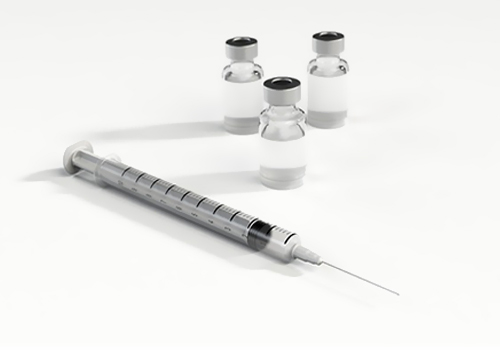Injectable

An injection (often and usually referred to as a "shot" in US English, a "jab" in UK English, or a "jag" in Scottish English and Scots) is the act of administering a liquid, especially a drug, into a person's body using a needle (usually a hypodermic needle) and a syringe.[1] An injection is considered a form of parenteral drug administration; it does not involve absorption in the digestive tract. This allows the medication to be absorbed more rapidly and avoid the first pass effect. There are many types of injection, which are generally named after the body tissue the injection is administered into. This includes common injections such as subcutaneous, intramuscular, and intravenous injections, as well as less common injections such as intraperitoneal, intraosseous, intracardiac, intraarticular, and intracavernous injections.
Injections are among the most common health care procedures, with at least 16 billion administered in developing and transitional countries each year.[2] Of these, 95% are used in curative care or as treatment for a condition, 3% are to provide immunizations/vaccinations, and the rest are used for other purposes, including blood transfusions.[2] The term injection is sometimes used synonymously with inoculation, but injection does not only refer to the act of inoculation. Injections generally administer a medication as a bolus (or one-time) dose, but can also be used for continuous drug administration.[3] After injection, a medication may be designed to be released slowly, called a depot injection, which can produce long-lasting effects.
An injection necessarily causes a small puncture wound to the body, and thus may cause localized pain or infection. The occurrence of these side effects varies based on injection location, the substance injected, needle gauge, procedure, and individual sensitivity. Rarely, more serious side effects including gangrene, sepsis, and nerve damage may occur. Fear of needles, also called needle phobia, is also common and may result in anxiety and fainting before, during, or after an injection. To prevent the localized pain that occurs with injections the injection site may be numbed or cooled before injection and the person receiving the injection may be distracted by a conversation or similar means. To reduce the risk of infection from injections, proper aseptic technique should be followed to clean the injection site before administration. If needles or syringes are reused between people, or if an accidental needlestick occurs, there is a risk of transmission of bloodborne diseases such as HIV and hepatitis.
Unsafe injection practices contribute to the spread of bloodborne diseases, especially in less-developed countries. To combat this, safety syringes exist which contain features to prevent accidental needlestick injury and reuse of the syringe after it is used once. Furthermore, recreational drug users who use injections to administer the drugs commonly share or reuse needles after an injection. This has led to the development of needle exchange programs and safe injection sites as a public health measure, which may provide new, sterile syringes and needles to discourage the reuse of syringes and needles. Used needles should ideally be placed in a purpose-made sharps container which is safe and resistant to puncture. Some locations provide free disposal programs for such containers for their citizens.

